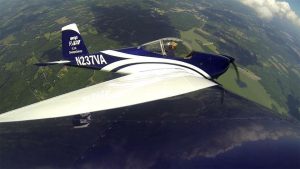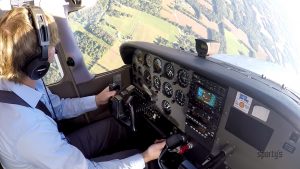How to master steep turns
|
Getting your Trinity Audio player ready...
|
 Steep turns were my nemesis. While I didn’t fail an exam as a result, it was clearly a weak maneuver within my repertoire. Never as clean and crisp as I would like. Never something I enjoyed. As I advanced with certifications, training and experience, my disdain for the perennial exam and proficiency requirement only grew. And then I stopped fighting and started flying.
Steep turns were my nemesis. While I didn’t fail an exam as a result, it was clearly a weak maneuver within my repertoire. Never as clean and crisp as I would like. Never something I enjoyed. As I advanced with certifications, training and experience, my disdain for the perennial exam and proficiency requirement only grew. And then I stopped fighting and started flying.
Maybe it’s not steep turns, but nearly all pilots can relate a maneuver in which we lack confidence in performing; maybe even to the point of fear. We find ways to cope, manage or mask the feeling of inadequacy. If we’re lucky, there will eventually be an instructor, fellow pilot, or maybe just a moment in time when it clicks. The fear subsides, the confidence builds, and we’re better pilots for it. For me it was learning to focus on the right things at the right time.
It’s conceivable that a 45 degree banked turn could be needed for an evasive maneuver, but we don’t practice or require the execution of steep turns so that we can make them a part of our everyday flying. In fact, they should largely be avoided. Steep turns are a staple in our training regimen for a better understanding of the aerodynamics associated with turns and to help develop smooth and coordinated use of flight controls, division of attention, and general mastery of the aircraft to aid all of your flying.
 Private pilot airman certification standards prescribe a 360 degree turn at 45 degrees of bank. Altitude is to be maintained +/- 100 feet, airspeed within 10 knots, and bank +/- 5 degrees with a roll out on the entry heading +/- 10 degrees. The direction of turn is at the discretion of the examiner (or applicant) and it’s common to complete a 360 degree turn in the opposite direction immediately following the first turn. It’s sound practice to ensure the area of the intended maneuvering is clear before commencing and be sure to complete a basic pre-maneuver checklist.
Private pilot airman certification standards prescribe a 360 degree turn at 45 degrees of bank. Altitude is to be maintained +/- 100 feet, airspeed within 10 knots, and bank +/- 5 degrees with a roll out on the entry heading +/- 10 degrees. The direction of turn is at the discretion of the examiner (or applicant) and it’s common to complete a 360 degree turn in the opposite direction immediately following the first turn. It’s sound practice to ensure the area of the intended maneuvering is clear before commencing and be sure to complete a basic pre-maneuver checklist.
Set the stage for success by being configured and stable prior to entry. Searching for speeds and altitudes during the maneuver will not yield a good outcome. Memorize the power setting needed to enter the maneuver at the recommended airspeed. Just as important, memorize the additional power needed to maintain speed throughout the maneuver (as drag increases, additional power will be needed to maintain airspeed). Practice adding and subtracting power through feel only and without referencing the tachometer. Less time spent including the power instrument in your scan, the more time you can focus on your airspeed, altitude and bank angle.
When selecting an entry point, a prominent visual reference on the horizon is important, but select a visual point that also aligns with a cardinal heading. A cardinal heading will be much easier to identify in a quick scan of the heading indicator and serves as a back up or insurance to the visual reference point.
 As you enter the maneuver, anticipate the additional back pressure necessary to maintain the required pitch. It’s common for the nose to drop initially due to a lack of back elevator resulting in rapid loss of altitude. Be deliberate in memorizing the correct feel and understand back elevator pressure should be increasing steadily as you roll into the 45 degrees of bank. It’s ok to make use of elevator trim; however, some pilots prefer to feel the necessary pressure without the use of trim. No matter your choice, practice the same method each and every time.
As you enter the maneuver, anticipate the additional back pressure necessary to maintain the required pitch. It’s common for the nose to drop initially due to a lack of back elevator resulting in rapid loss of altitude. Be deliberate in memorizing the correct feel and understand back elevator pressure should be increasing steadily as you roll into the 45 degrees of bank. It’s ok to make use of elevator trim; however, some pilots prefer to feel the necessary pressure without the use of trim. No matter your choice, practice the same method each and every time.
Steep turns require prompt flight control inputs. Small corrections for pitch are accomplished with elevator pressure while the bank angle is held constant with the ailerons. Use the bank angle tolerance of five degrees to your advantage when making corrections. If altitude is decreasing, reduce bank angle (horizontal component of lift) slightly before making a pitch correction. This small adjustment in bank may be all that is necessary to stop the decreasing altitude trend. Conversely, if altitude is increasing, increase bank angle slightly before making a pitch correction. Continuous, rapid pitch adjustments without the finesse of bank angle adjustment is the difference in fighting the airplane versus flying the airplane and can even exaggerate altitude deviations.
Spot the trends and take action. A satisfactory commitment to the visual site picture will ensure you spot altitude deviations immediately. A mental database of steep turn pictures will reinforce the correct picture. Make use of the quality video-based resources available so that you can view and review steep turns from the pilot’s perspective. Take your own video or pictures to aid in your study.
On the panel, a quick, accurate scan will supplement what you’re seeing on the horizon and will be key in the performance metrics to which you’re being held. It’s important within your scan to recognize trends for additional feedback on the amount of control input needed for corrections. It’s not enough to see that altitude is decreasing, you need to also know how quickly altitude is deviating. The vertical speed indicator is a direct indicator of altitude trend and important to include in the instrument scan.
The rollout from the turn must be started before reaching the desired heading. A rule of thumb is to lead by one-half the angle of bank or about 20 degrees ahead of your desired heading in the case of the 45-degree steep turn. Don’t ignore rudder input in the direction of the rollout or toward the high wing. Coordination is important during all phases of the maneuver. As the angle of bank decreases, the elevator pressure should be relaxed at the same rate it was applied during roll-in. If trending toward an undershoot, slow the rate of rollout. If trending toward an overshoot, increase your rollout rate and use additional rudder input to lock in on your desired heading.
I find it helpful in the execution of steep turns to practice in a variety of conditions and scenarios. Begin some turns to the right versus left. Execute 180 degree turns in addition to 360 degree turns. Seek out days for steep turn practice with haze or scattered clouds. This all helps in accomplishing the objective of steep turns.
What I once viewed as punitive, I now approach with enthusiasm. I know the lessons learned are fundamental to all flight maneuvers. I look forward to the continual refinement in skills necessary to accomplish steep turns. In other words, I learned to stop fighting the airplane and fly the airplane.
The steep turn video tutorial is from Sporty’s complete Learn to Fly Course.
- Pilot’s Guide to Special Use Airspace (SUA) - June 16, 2025
- Ready for the Real-World IFR Experience? Join IFR Focus - June 13, 2025
- FAA Issues Call to Action: Know Before You Go - May 23, 2025


